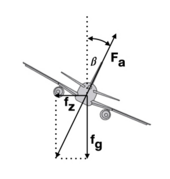Turning

As curve flight all flight maneuvers referred to in which the pilot of the aircraft performs a controlled change of direction.
Correct coordination
For an aerodynamically correct turn, the aircraft must assume the inclined position in which the centrifugal force precisely counteracts the sideways gliding due to the transverse slope (see dummy vertical ). In many aircraft, a turn indicator is available to control correct coordination of the turn , which is one of the minimum equipment required for instrument flight . In scheduled flights, 30 ° is the maximum bank angle.
control
Turning is initiated by operating the ailerons and rudder at the same time . The rudder compensates for the negative turning moment caused by operating the ailerons. For control with autopilot only the desired change of direction (or is heading ) inputted from the device and the rate of rotation controlled (up to 3 ° per second) with the appropriate bank. The autopilot is linked to horizon sensors for this purpose .
history
In 1902 , the Wright brothers discovered the need to support turning with ailerons or wing twisting in addition to the initiation of a bank angle with their double-decker glider during gliding flights . Only the attachment of a movable rudder and the synchronization of its deflections with the twisting of the wing made it possible to cancel out the negative moment and thereby maneuver at will.
physics
Curve radius
In order to make an aircraft fly a curve with the radius , the aircraft must be accelerated centripetally in the direction of the curve center with the acceleration . In order to achieve this acceleration, a centripetal force must act on the plane of the mass . This force is created with the lift of the wings by tilting the aircraft towards the center of the curve. When the aircraft is tilted, the lift of the wings is vectorially divided into a vertical and a centripetal (horizontal) component. The vertical, by acting above component is the weight of the aircraft and in the opposite direction has same amount as the weight of: . With the aircraft inclination angle ( English called bank angle ) the centripetal force is expressed in magnitude
and thus is
Here represents the acceleration due to gravity . The curve radius that an airplane flies at speed and an angle of inclination is:
At a certain angle of inclination, the curve radius increases as the square of the speed and it is independent of the size of the aircraft (or bird) in question.
Examples
A Beechcraft Bonanza A36 flies in cruise at a speed of 160 kt (296 km / h). At an incline of , the radius of the flown curve is 1194 meters.
An airliner flies when cruising at a speed of, for example, 450 kt (833 km / h). At an incline of , the radius of the flown curve is 9453 meters.
Standard curve
A standard curve is used when an aircraft flies a 360 ° circle in two minutes. The distance flown in a circle is . To fly this circle in two minutes , the aircraft must bank
to have. For 'small' speeds is
a good approximation .
A Beechcraft Bonanza A36 , which has a cruising speed of 160 kt (296 km / h), flies a standard curve at a bank angle of .
g factor
The g-factor acting on the aircraft and the occupants in a curve , also known as the load factor , is the ratio of the lift required in the curve ( ) to the lift in level flight.
The g-factor is very low for bank slopes up to 30 ° and hardly noticeable as a passenger. The g-factor increases steeply for bank slopes over 30 °. For every flying object, be it an airplane or a bird, the load factor is independent of mass and independent of speed at a bank angle of 60 °.
Example: A Beechcraft Bonanza A36 may be loaded with a g-factor of a maximum of 4.4 with its landing flaps retracted and maximum take-off weight . This load factor is achieved with a lateral inclination of 77 °.
Effect of forces on pilots and passengers

When turning, an aircraft is an accelerated system. Within this system, the pilots and passengers are affected by gravity and the (horizontal) centrifugal force , with the mass of the passenger or pilot being considered here . The two forces add vectorially into a resultant, the direction of which is opposite to the lift and always pushes the aircraft occupants vertically into the seat , regardless of the bank's inclination , with the weight increased by the load factor. In contrast to driving a car, pilots and passengers are never pushed sideways from the seat, even in very steep turns.
See also
- Sliding curve (skid) and lubricating curve
- Joystick
- Gyrosyn
- Standard curve
Individual evidence
- ↑ a b The aircraft symbol used in the image was the icon Airplane-from-behind.svg removed
- ↑ Airplane Flight Manual of the Beechcraft Bonanza A36, pages 2–11 (accessed January 30, 2019)




























